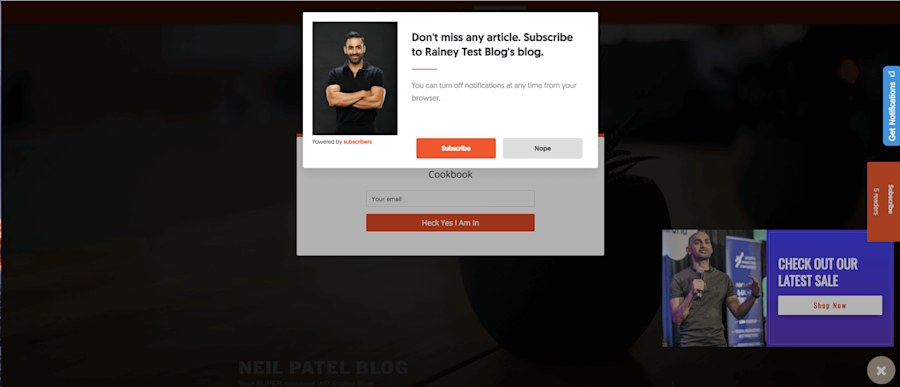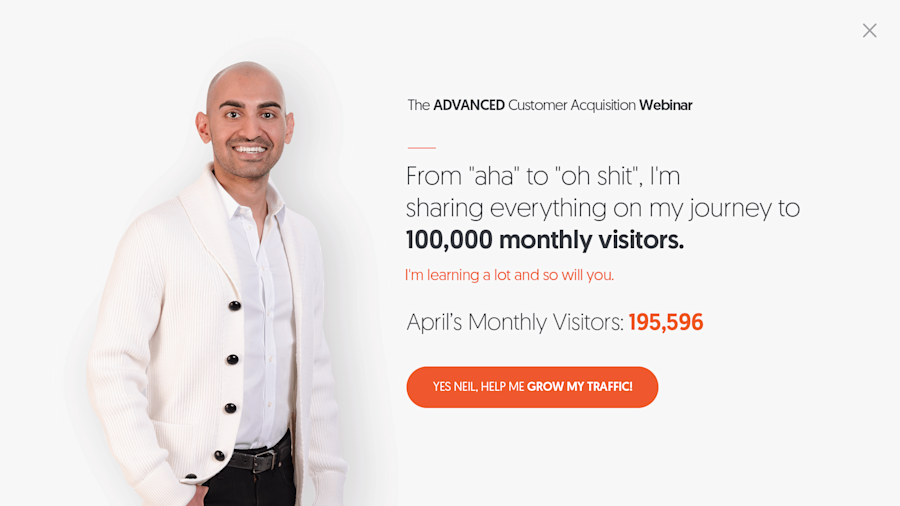Let this soak in for a second: 98% of your website visitors are leaving your site without taking action.
That means…
For every 1,000 visitors that come to your website, 980 leave without taking action.
For every 10,000 visitors that come to your website, 9,800 leave without taking action.
For every 100,000 visitors that come to your website, 98,000 leave without taking action.
Why are they leaving, you ask?
Well, there are many reasons why people may be leaving:
There are too many calls to action on your website
The call to actions are appearing too soon
The content of your site is overwhelming
Your website is not user friendly
The list can go on and on, but there is a bigger reason that people are leaving your site – you aren’t giving them a reason to stay.
You aren’t giving them something so exciting and enticing that they can’t wait to stay on your website.
So, how do you do that?
First and foremost, you have to understand your ideal client and customer. Then, with this person in mind, you will need to map out the exact experience you want them to have as they travel through your site.
One of the hardest parts about creating a customer journey is feeling like you are shooting in the dark. It can be intimidating to feel like you don’t know exactly what to do, or how to set your site up. After all, a lot of work goes into this process, and you don’t want it to go to waste.
What if you have your ideal client in mind, but find that a totally different type of customer is coming to your site? That is why a solution like Leadfeeder is so vital. Website visitor tools can help ensure that you have a good understanding of the companies and customers that are hitting your website each and every day, taking doubt or insecurity out of the equation. You can be sure that any work you do is with the right ideal client in mind.
By understanding not just your ideal client, but the true ideal client that your website caters to, you can start to get people to actually stay on your website.
Here are three quick steps to map out that ideal client’s journey through your website so you can start converting the visitors that are coming to your website into long term customers and sales.
Step 1: You must understand your ideal client (aka Avatar)
In order to know how to get people to stay on your website, you need to understand who is coming to your website. Here are three vital things you need to know.
Details About The Traffic To Your Website: Where are people coming to your website from? A cold lead, such as one from a paid ad that has otherwise never heard of your business before, most likely needs to be warmed up before they are going to hand their money over to you. Someone that is a warmer lead (they came from referral or perhaps organically from one of your social media networks) doesn’t need as much warming up before they take action. Knowing how familiar your leads are with your business is essential to knowing how best to reel them in to making a purchase on your site.
The Complete Identity of Who Your Ideal Client Is: What style company are they working for – B2B? B2C? Digital Marketing? E-commerce? Understanding what type of business they have and who they are is key to knowing what journey to provide for them on your website. This is important because if your entire site has content for digital marketers, but your ideal client is more corporate, people are going to leave your website because they aren’t finding what they are looking for.
The Solution Your Ideal Client Is Seeking When They Come To Your Website: People buy based on pain, ie. based on the problems that are causing them anguish in the current moment. If someone gets to your website and doesn’t see a solution to the problem they are hoping to solve, they probably aren’t going to stay. However if you provide them with a quick win or solution to their problem through a free offer, they are far more likely to trust your brand and take the action step you want them to take in the future.
Step 2: You must determine what the ultimate purchase goal is for your visitors
At the end of the day, what is the ultimate goal you have for your website visitors – Do you want them to buy your ecommerce product? Do you want them to hire you as a coach or consultant?
Perhaps you want them to buy your software.
In order to map out your customer journey, you have to know where you ultimately want your website visitors to go on your website.
What happens when you don’t have a goal for your website visitors?
A messy site that causes people to leave without taking action like the image below!

For example, this image shows too many calls to action. An intrusive user experience. All because there is not one main path that this site wants to users down.
Pro Tips:
Focus on one goal at a time. I always suggest creating a quarterly marketing plan every 90 days for your business. Include your website in this. What is it that you want to focus on selling online for the quarter? What steps can you take to achieve this – are there certain sales or promotions?
Have all of your call to actions on your website point to one goal. If you want to increase your free trials for the quarter, have all of your call to actions lead your visitors straight to your free trial sign up. If you want to bring on 10 more agency clients, have all of your call to actions lead to a form to have a call with you. Think about what action is most important on your site and use your call to actions to guide your customer through those actions specifically.
Make sure your call to actions are visible. We find that call to actions are often times hard to find, which means the results you get are less than mediocre – after all, how can someone take an action if they can’t see it? To be sure your site visitors see your call to actions, you can use softwares like Hello Bar to ensure that your offer is visible. We love using the page takeover upon exit – this has gotten us an additional 900 sign ups to Hello Bar per month since we deployed it, just by increasing visibility to site visitors.
Step 3: Think about what your ideal customer needs to do or see before they buy from you
The last step of creating a killer customer path is filling in the middle of the customer journey. You have the starting point (where they are coming from). You have the endpoint (where you want them to go). Now you need to fill in the middle. How do you get them to where you want them to go?
This is where you ask yourself what does your ideal customer need to do or see before they hire you or buy from you?
For e-commerce sites, this could be free shipping or a savings discount.
For an agency or big software company, this could be a consultation or a live demo.
For a coach or consultant, this could be a free call.
For those trying to sell an online course, this could be a mini series, challenge or even some sort of checklist or guide that allows them to get a taste of the course.
Usually, you fill in this middle part of the customer journey with a free offer. But long gone are the days where you can just offer a “free call” or a “Join my newsletter.” That just doesn’t stand out anymore.
So, how do you get people to take your free offer?
You have to go back to the ideal client and what solution they are seeking. Why are they coming to your website? What pain points do they have that you can solve for them? If you have an offer that gives them a solution to the problem they are facing, they are going to take it.
Let’s look at an example.
On neilpatel.com (our co-founder’s company), we had a goal two years ago to sell his Advanced Marketing course.
We approached selling this course by breaking down every step of a customer’s journey through his site.
Problem: In terms of pain points, we realized that people came to Neil to get more traffic to their website. Their problem was not getting enough traffic, or simply wanting more traffic.
Solution they were seeking: Get more organic traffic to their site.
How did we solve that problem?
Goal: Our ultimate goal as was to sell people our AMP course, which gave them the A-Z to build their digital marketing business and get traffic to their site.
We asked ourselves, what do they need to do or see before they will buy the product?
We decided that the best offer we could give that provided the absolute most value to our ideal customer was a webinar. So we did just that.
Every call to action on the website led to the Free Webinar. The free webinar ultimately led to introducing the course, which in turn allowed us to sell over 6,000 courses.
The key to our success was having just one goal for the website. While we did use multiple Hello Bar pop-ups that had different text and messaging between them, everything led to the same offer – the webinar. There was nowhere for the customer to get lost or confused while journeying through the site and towards a purchase.

Conclusion
At the end of the day, you have to keep it simple. Over my 15 years of marketing experience, I can’t tell you how many websites I have seen that don’t convert well (even after people spend 50K + on them) because they just aren’t simple.
Mapping out your customer journey to and through your website is the most important step you can take.
When it comes down to it, there are a few key things you must know for your customer journey:
Who is coming to your website? (that is why softwares like leadfeeder are so awesome)
What is your goal for your website?
What do people need to do or see before they hire you?
If you can master these three questions, from there you can create the ultimate user experience that will have people staying on your website and converting into long term sales and customers.
Get more from your web analytics.
t’s time to turn your website traffic data into something more meaningful. Website visitor analytics enable you to identify and qualify the companies visiting your website, even when they don’t fill out a form.
Show me how



